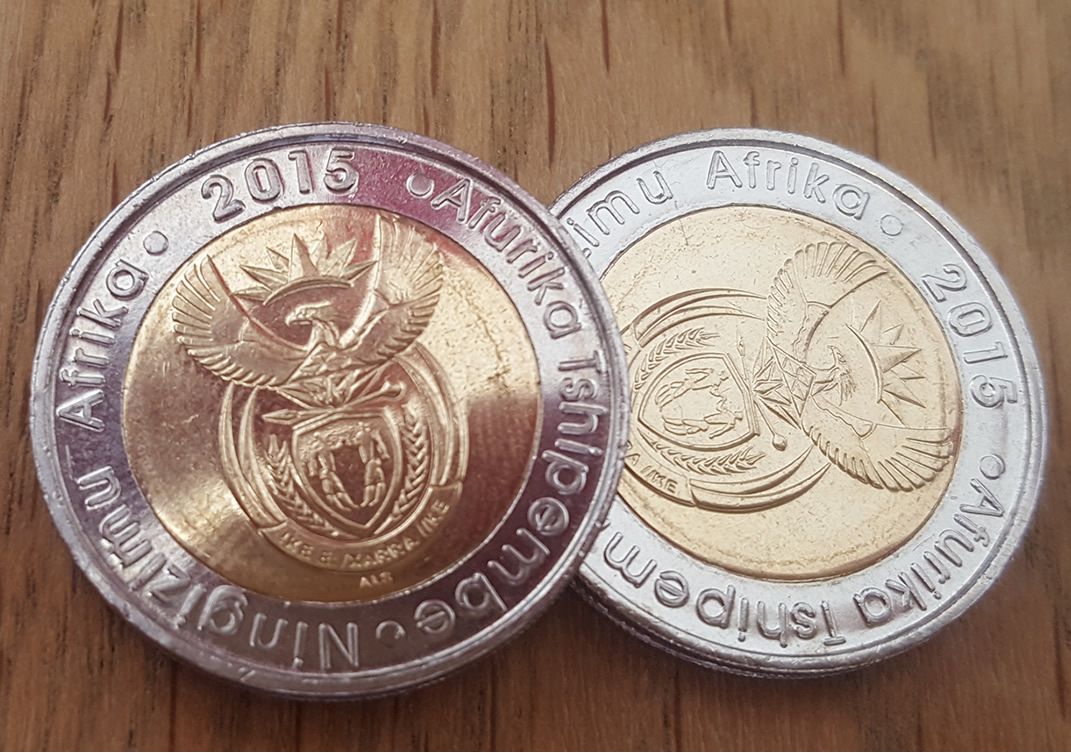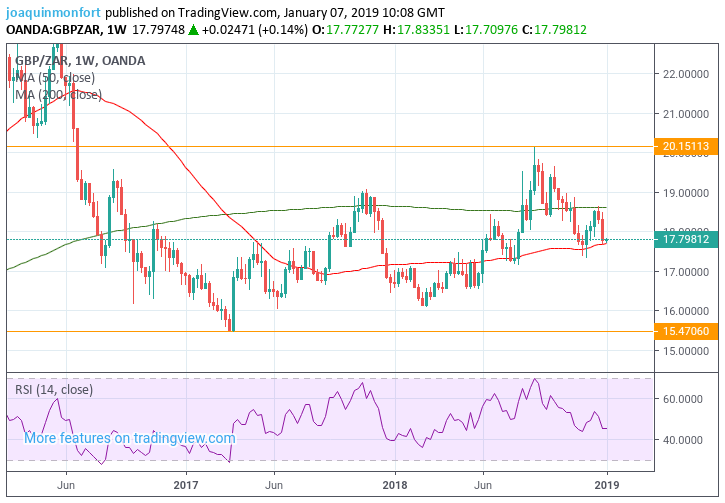The Pound-to-South African Rand Rate in the Week Ahead: Bearish Bias Remains in Place

© Pound Sterling Live
- GBP/ZAR rate falling within long-term range
- 50-week moving average provides support.
- GBP eyes GDP as ZAR looks to global factors.
The Pound-to-Rand rate has fallen for seven consecutive days in a row and is likely to continue trading with a bearish bias in the week ahead.
The pair has been pressured lower by a strengthening Rand more than anything else, which has appreciated due to an increasingly negative U.S. Dollar outlook. The Rand is senstive to the greenback.

Above: Pound-to-Rand rate shown at weekly intervals.
The Pound-to-Rand rate has been trading inside a broad range between 20.00-to-15.00 for roughly the last two years and more recently, it has been descending within the range from highs struck in September.
One key feature of the weekly chart currently is the location of the 50-week moving average at 17.71, which coincides with the level of the current lows and is likely to act as a floor that resists a deeper slide.
This MA needs to be broken for the exchange rate to move sustainably lower.

Above: Pound-to-Rand rate shown at daily intervals.
Despite a brief recovery during the month of December, the pair has renewed its descent at the start of 2019.

Above: Pound-to-Rand rate shown at 4-hour intervals.
The 4hr chart above shows the latest sequence of declines in more detail and suggests the short-term trend remains bearish. The trend is likely to remain downward although a break below 17.60 is required to confirm of a more extensive decline down to the 17.35 December 3 low.
The South African Rand: What to Watch
The main release in the week ahead for the Rand is the ABSA manufacturing PMI for December. This came in at 49.5 the previous month which, being below 50, suggests the sector is in contraction territory.
If the PMI continues to register a sub-50 reading the Rand may suffer as a consequence. South Africa (SA) experienced a brief recession in 2018 and a continued decline in manufacturing activity could raise fears of another recession.
The other key fundamental driver for the SA unit is the value of the Dollar, with which it is negatively correlated, because so much SA debt is denominated in Dollars. A stronger Dollar increases the cost of the repayments, putting companies under more pressure.
Currently the Dollar is trading in a more subdued manner as a result of declining interest rate expectations, and commentary from members of the rate-setting Federal Open Market Committee could impact currency markets if they reinforce this more 'dovish’ (meaning in favour of lower interest rates) stance.
Currencies are impacted by interest rate changes because they effect net inflows of foreign capital. When interest rates move higher net inflows do to, increasing demand for a currency because of the destination's relative attractiveness to investors from a returns perspective.
The Pound: What to Watch
The UK enters a critical three week period as parliamentarians return to Westminster to debate the merits of the Government's withdrawal deal with the EU. A vote is due in the week commencing January 14.
At present, the deal is expected to be voted down by legislators amidst a lack of fresh concessions from the EU. The government is expected to bring the deal back before parliament for a second vote in the event of the first vote failing.
However, any second vote must contain some material changes, so we expect the EU to offer something in the near future as they will know only too well that the deal they worked on over the past 2 years will not pass in its current form.
Sterling will likely trade relatively subdued, range-bound levels until the point it becomes clear that either 1) May's deal will pass or 2) a No Deal Brexit is going to happen in March 2019. We will be watching the newswires for any indications that a decisive shift in either direction has occurred.
The Pound's rise on Friday was in part driven by the release of better-than-expected services sector data, but in the week ahead the focus will be more on the heavier parts of the economy with industrial and manufacturing production data for November scheduled for release, as well as, of course, GDP.
Industrial production is forecast to end a 3- month losing streak in November, when it is released at 10.30 GMT, on Friday, and forecast to show a 0.2% rise. Manufacturing is forecast to show a 0.4% gain when it is released at the same time: these would contrast with -0.6% and -0.9% respectively in October.
Monthly GDP data for November is also out at the same time on Friday and is expected to show a 0.1% rise month-on-month, the same as it did in October, and a 1.3% rise year-on-year.
Despite growth in the UK being weak, it remains about the same as in the Eurozone.
“Despite the Brexit gloom and gridlock in Parliament over the withdrawal deal, the UK economy does not seem to have slowed down anymore than its European counterparts and probably managed growth of 0.1% in November, estimates are anticipated to show,” says Rafi Boyadjian, an analyst at broker XM.com.
The other key economic release for the Pound is trade balance data, also out on Friday.
Advertisement
Bank-beating exchange rates. Get up to 5% more foreign exchange by using a specialist provider to get closer to the real market rate and avoid the gaping spreads charged by your bank when providing currency. Learn more here




